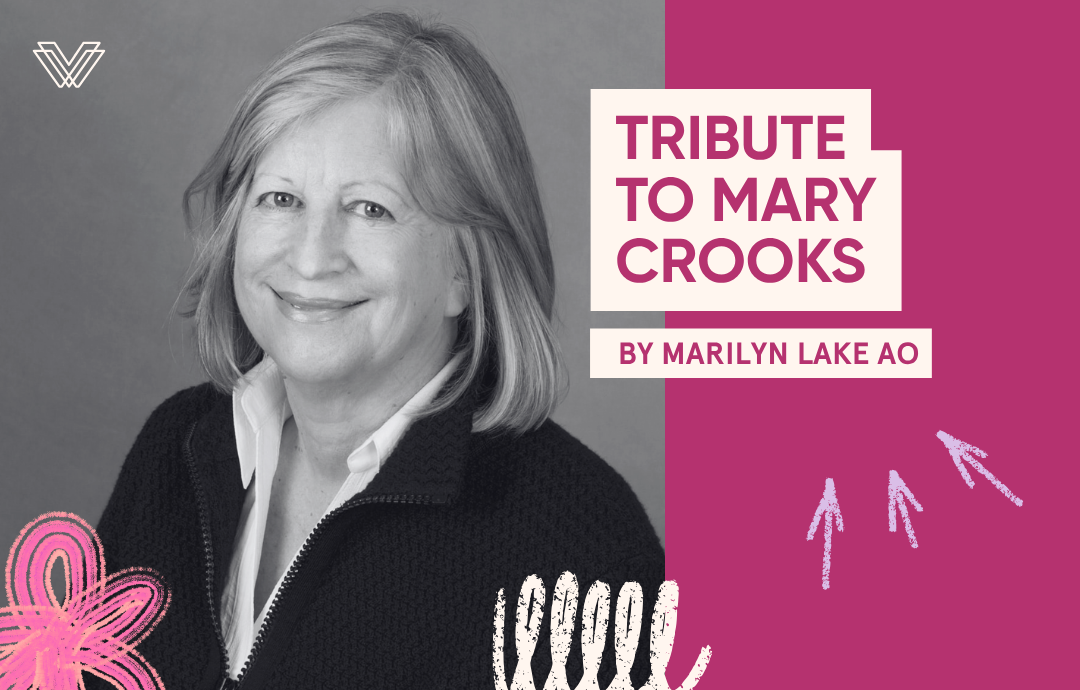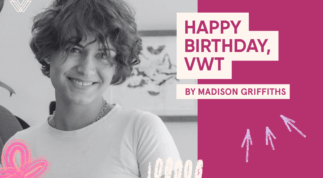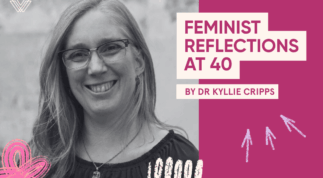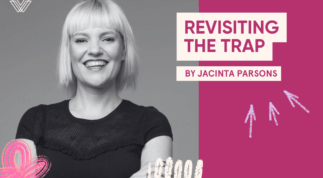I was honoured and excited to work with the inimitable Mary Crooks and serve as a Director and Board member of the Victorian Women’s Trust (VWT) from 2005 until 2011.
I’m an academic historian, public speaker and writer. Mary and I came together at the end of the 20th century. We enjoyed each other’s company and inspired each other in our public activism. She aimed to use feminist philanthropy, advocacy, mobilisation, lobbying and publication to bring about real change – especially improvements in women’s lives – at all levels of society. She also insisted on the importance of women’s history in highlighting how feminist activism in the past had achieved political, economic and social change and showing how the past shapes the present – in all its limits and opportunities – and future possibilities.
Mary also knew how crucial women’s work – paid and unpaid, productive and reproductive – was to sustaining families, communities and nations.
This insight and commitment informed many of the distinctive projects she initiated such as the Purple Sage / Kitchen Table Conversations movement, that ultimately laid the foundations for the success of Teal Independents in more recent times. She initiated the exhibition and book Ordinary Women, Extraordinary Lives, a project to mark the centenary of federation in 2001 and relatedly the commemorative ‘monster petition’ sculpture, commissioned to mark the centenary of women’s suffrage in Victoria in 2008. Feminist history as a transformative academic pursuit was then in its heyday and the VWT, with Mary at the helm, also made history in its indefatigable advocacy, philanthropic work, publication program and creative interventions in public life.
In 1994, four Melbourne-based feminist historians – Pat Grimshaw, Ann McGrath, Marian Quartly and I – published the first feminist history of Australia we called Creating a Nation. It was the first such project anywhere in the world. We documented the significance of women’s lives and work broadly conceived, over two centuries, in helping to build the nation, to make a nation, but we also noted white women’s complicity in colonisation – their role in the dispossession and displacement of Indigenous peoples. We documented women’s political mobilisations, but also the class and race relations that divided women. In the Introduction we wrote:
‘The creation of nations has traditionally been seen as men’s business….We wish to challenge this view of history, by asserting the agency and creativity of women in the process of national generation’.
Published by McPhee Gribble ( Penguin) Creating a Nation was launched in La Trobe University Bookshop by Premier Joan Kirner.
Five years later I published Getting Equal: The history of Australian feminism ( Allen and Unwin, 1999) in which I documented women’s political mobilisations over two centuries that targeted domestic violence, women’s poverty, care workers’ vulnerability, and women’s powerlessness. Feminists in Australia since the time of Rose Scott , Louisa Lawson and Jessie Street have long championed equal political rights, the economic independence of women and care workers’ right to an income. They critiqued marriage – this ‘house of bondage’ – and the prevalence of violence against women. The VWT generously sponsored the book launch, which featured a range of speakers, including Merle Thornton and the inimitable choir leader and musician Kavisha Mazzella – all filmed by distinguished film-director Sue Maslen – in the South Melbourne Town Hall. Soon after I joined the Victorian Women’s Trust Board.
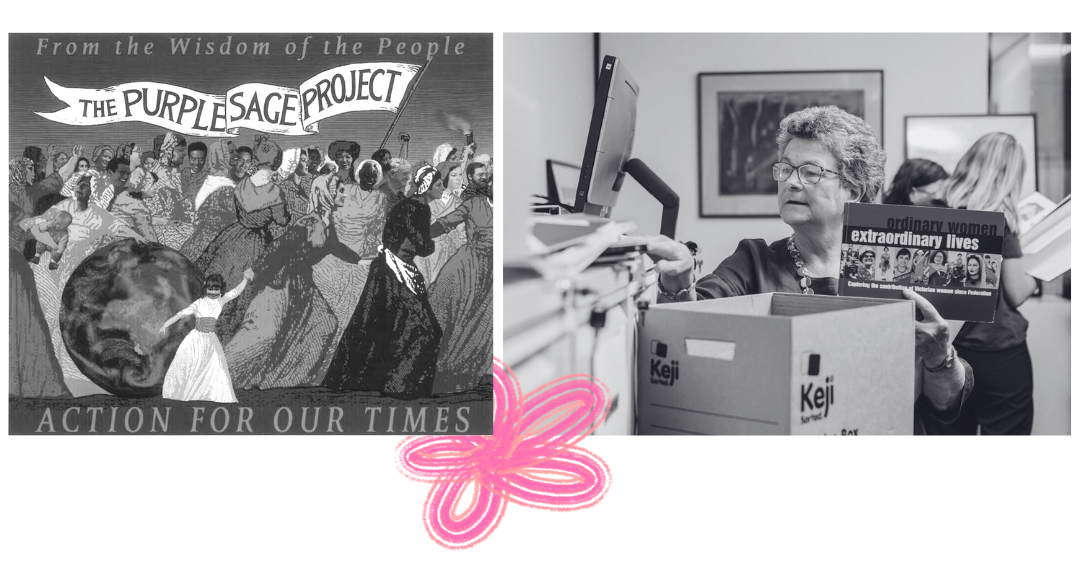
Image left: Promotional poster for The Purple Sage Project. Image right: Former VWT Executive Director Mary Crooks AO discovering the Ordinary Women, Extraordinary Lives book in the VWT archives. Image by Breeana Dunbar.
In 2008 Mary re-published Vida Goldstein’s Woman Suffrage in Australia, first published in 1908 to tell the world about the achievements of the first women in the world to achieve full political rights. In that year, too, the Trust took the lead commemorating one hundred years of ‘women’s democratic participation in Victoria’ with a series of public discussions, led by Pat Grimshaw, Judy Smart and me and the premiere of the Women’s Anthem ‘Love and Justice’.
VWT also contributed towards the public sculpture by Susan Hewitt and Penelope Lee celebrating the centenary of women’s suffrage in Victoria that stands in Burston Reserve near Parliament House. The ribbon sculpture specifically refers to the ‘monster petition’ that contained 30,000 signatures of women, collected in the 1890s, seeking the right to vote. It was a sculpture deliberately designed to commemorate not an individual, in the patriarchal tradition, but a collective movement for change.
Like the many campaigns later led by the VWT, the winning of political rights was a collective achievement.
The VWT is a unique feminist organisation that combines advocacy, fund-raising, philanthropy, publication and policy submissions. Its programs have been animated by Mary’s defining passion for democracy as a work in progress and the necessity of community participation. I think of the Purple Sage project that sought to bring people together to counter the effects of neo-liberalism – as exemplified by the actions of the Kennett government – before most commentators recognised what was befalling us.
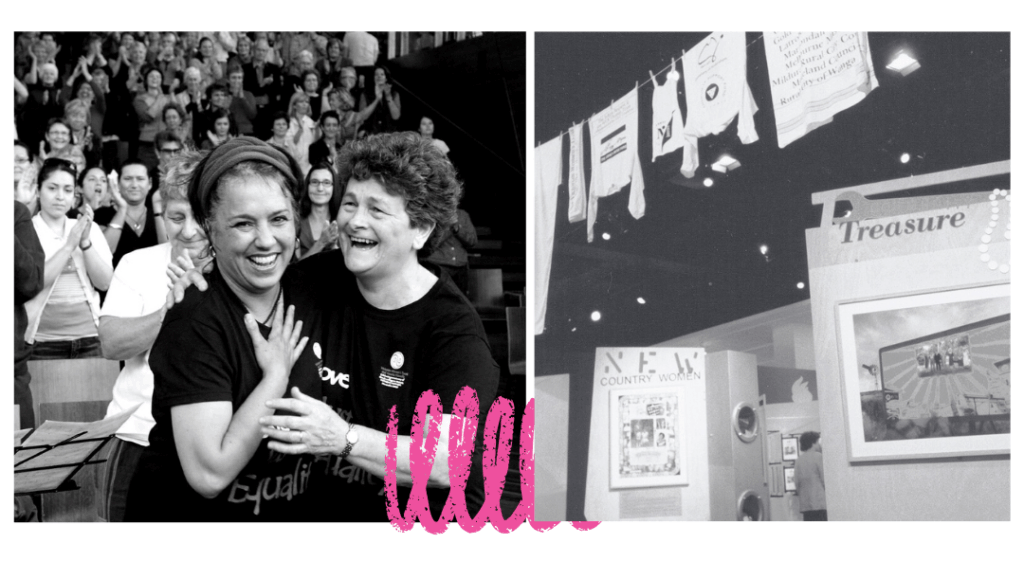
Image left: Composer Kavisha Mazzella with former VWT Executive Director Mary Crooks AO at the performance of the Love and Justice Women’s Anthem at The Edge in Federation Square.
Image right: The Ordinary Women, Extraordinary lives exhibition.
Now in 2025 the terrible state of our universities testifies to the long term impact of neo-liberal cuts, privatisation, wage theft and deepening economic inequality. The community engagement pioneered by Purple Sage was extended into the Watermark project and the Ordinary Women, Extraordinary Lives exhibition and catalogue.
In an article for the Age on that project I wrote on 2 June 2001:
‘The significance of this exhibition is that it suggests the need to not just admire women’s contributions to Victorian and Australian history, but to theorise it afresh’.
I meant that we should see women’s lives and work – paid and unpaid – as essential to society, as foundational to all that we do.
Mary Crooks recognised this and the astonishing range of grant-making – and the Sub-Fund program – are testament to this and to Mary’s determination that this feminist work continues into the future.
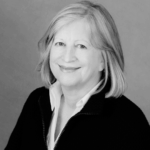
Professor Marilyn Lake is one of Australia’s most distinguished and esteemed historians. Her areas of research include settler colonialism and the British empire, campaigns for racial and gender equality, labour history and the impact of war on the home front. Professor Lake is author of several influential works such as Drawing the Global Colour Line (2008) with Henry Reynolds, and Progressive New World: How Settler Colonialism and Transpacific Exchange Shaped American Reform (2019). In 2018 Professor Lake was appointed an Officer of the Order of Australia (AO) in recognition of her distinguished service to higher education and historical organisations.
